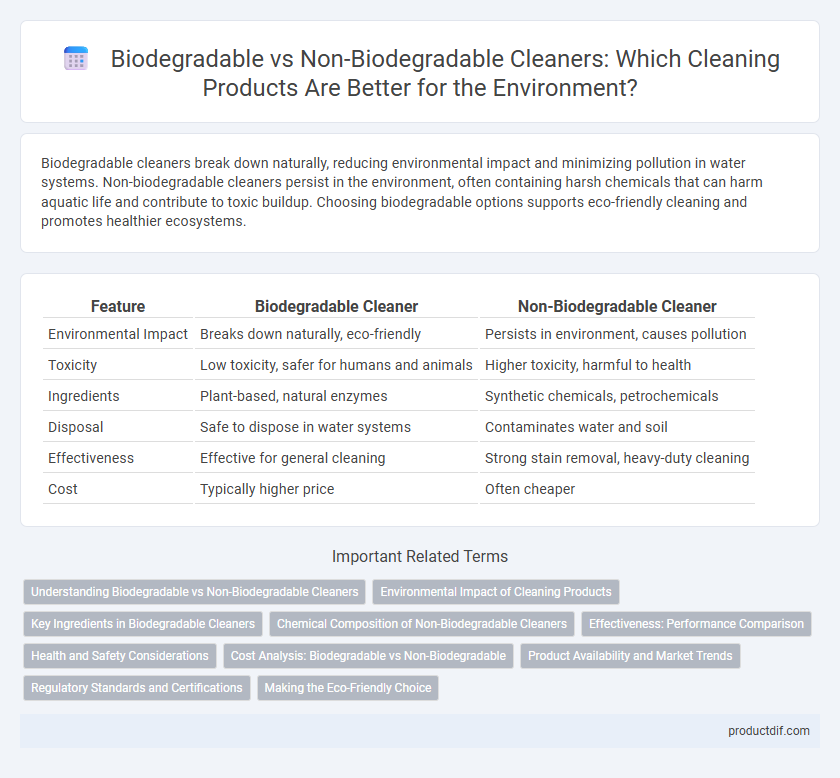Biodegradable cleaners break down naturally, reducing environmental impact and minimizing pollution in water systems. Non-biodegradable cleaners persist in the environment, often containing harsh chemicals that can harm aquatic life and contribute to toxic buildup. Choosing biodegradable options supports eco-friendly cleaning and promotes healthier ecosystems.
Table of Comparison
| Feature | Biodegradable Cleaner | Non-Biodegradable Cleaner |
|---|---|---|
| Environmental Impact | Breaks down naturally, eco-friendly | Persists in environment, causes pollution |
| Toxicity | Low toxicity, safer for humans and animals | Higher toxicity, harmful to health |
| Ingredients | Plant-based, natural enzymes | Synthetic chemicals, petrochemicals |
| Disposal | Safe to dispose in water systems | Contaminates water and soil |
| Effectiveness | Effective for general cleaning | Strong stain removal, heavy-duty cleaning |
| Cost | Typically higher price | Often cheaper |
Understanding Biodegradable vs Non-Biodegradable Cleaners
Biodegradable cleaners break down naturally through microbial activity, reducing environmental impact and preventing long-term pollution. Non-biodegradable cleaners contain synthetic chemicals that persist in ecosystems, leading to soil and water contamination. Choosing biodegradable cleaners supports sustainable cleaning practices by minimizing toxic residues and promoting ecosystem health.
Environmental Impact of Cleaning Products
Biodegradable cleaners break down naturally through microbial activity, reducing pollution and minimizing harm to aquatic ecosystems compared to non-biodegradable cleaners that persist in the environment and contribute to toxic buildup. Non-biodegradable cleaners often contain harsh chemicals such as phosphates and surfactants that can cause eutrophication, damaging freshwater habitats and biodiversity. Choosing biodegradable products supports sustainable waste management and lowers the carbon footprint associated with chemical manufacturing and disposal.
Key Ingredients in Biodegradable Cleaners
Biodegradable cleaners primarily use natural surfactants derived from plant-based sources such as coconut oil and corn, which break down easily in the environment, reducing pollution and toxicity. Enzymes and microbial agents are also key ingredients that enhance the breakdown of organic waste without harming ecosystems, unlike synthetic chemicals found in non-biodegradable cleaners. These natural components ensure effective cleaning power while supporting sustainability and minimizing harmful environmental impact.
Chemical Composition of Non-Biodegradable Cleaners
Non-biodegradable cleaners typically contain synthetic surfactants, phosphates, and petrochemical-based solvents that persist in the environment due to their complex molecular structures. These chemical compounds resist natural decomposition processes, leading to accumulation in water systems and soil, which causes long-term ecological harm. The inclusion of stabilizers and preservatives further prolongs their environmental footprint compared to biodegradable alternatives.
Effectiveness: Performance Comparison
Biodegradable cleaners often contain natural enzymes and surfactants that break down organic matter efficiently, providing effective stain and grease removal in household and commercial cleaning. Non-biodegradable cleaners typically use synthetic chemicals that deliver strong, fast-acting results, especially on tough, stubborn residues but may leave harmful residues in the environment. Effectiveness varies depending on the cleaning task, with biodegradable options excelling in eco-friendly deep cleaning and non-biodegradable products favored for heavy-duty industrial applications.
Health and Safety Considerations
Biodegradable cleaners break down naturally, reducing harmful chemical residues that can cause respiratory and skin irritations, making them safer for both users and the environment. Non-biodegradable cleaners often contain harsh chemicals like ammonia and phosphates, which pose risks of toxicity, allergic reactions, and long-term environmental pollution. Choosing biodegradable options minimizes exposure to hazardous substances and supports healthier indoor air quality and safer waste management.
Cost Analysis: Biodegradable vs Non-Biodegradable
Biodegradable cleaners typically have a higher upfront cost due to environmentally friendly ingredients and manufacturing processes but offer long-term savings by reducing environmental cleanup expenses and regulatory fines. Non-biodegradable cleaners often incur lower initial prices but may lead to increased costs linked to pollution control and potential health hazards. Evaluating total cost of ownership reveals biodegradable options as more economical considering environmental impact and sustainability incentives.
Product Availability and Market Trends
Biodegradable cleaners are increasingly available in supermarkets and online retail platforms due to rising consumer demand for eco-friendly products. Non-biodegradable cleaners still dominate the market but face declining growth as stricter environmental regulations and sustainability trends influence purchasing behavior. Market data shows a significant year-over-year increase in biodegradable cleaner sales, reflecting a shift towards environmentally responsible cleaning solutions.
Regulatory Standards and Certifications
Biodegradable cleaners comply with strict regulatory standards such as the EPA's Safer Choice program and EU Ecolabel, ensuring they break down naturally without harming ecosystems. Non-biodegradable cleaners often lack these certifications and may contain persistent chemicals that contribute to environmental pollution. Certifications like Green Seal and NSF also validate the safety and environmental impact of biodegradable cleaning products, promoting sustainable consumer choices.
Making the Eco-Friendly Choice
Biodegradable cleaners break down naturally in the environment, reducing pollution and minimizing harm to aquatic life and soil quality. Non-biodegradable cleaners often contain harsh chemicals that persist for years, contributing to environmental degradation and toxic waste accumulation. Choosing biodegradable cleaners supports sustainable living by protecting ecosystems and promoting safer water quality.
Biodegradable Cleaner vs Non-Biodegradable Cleaner Infographic

 productdif.com
productdif.com